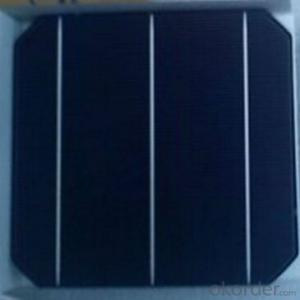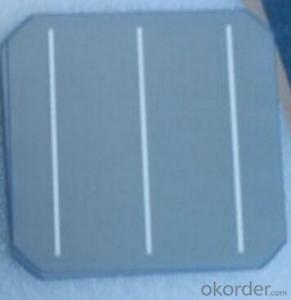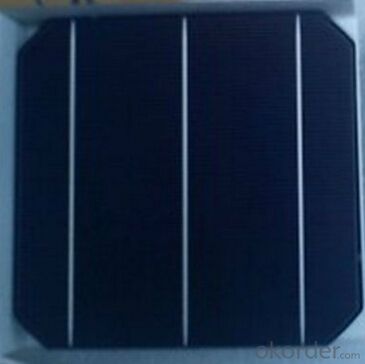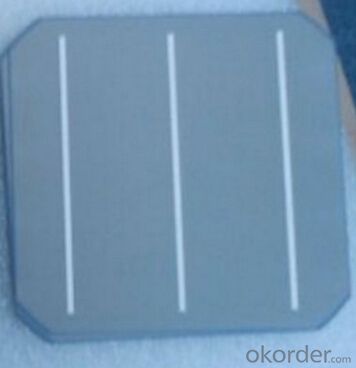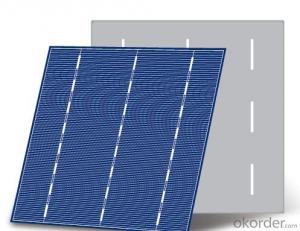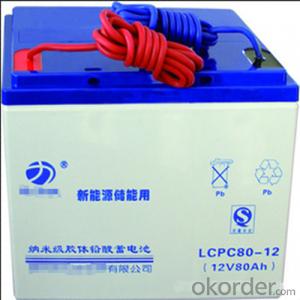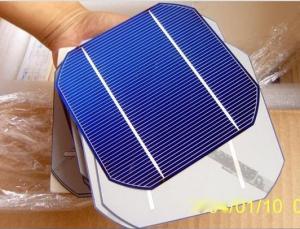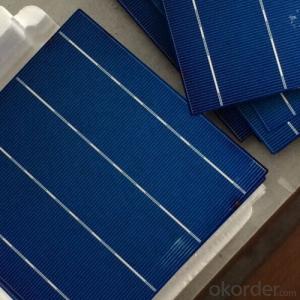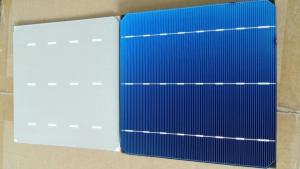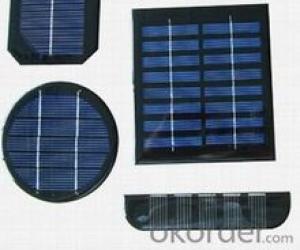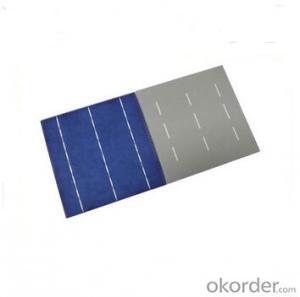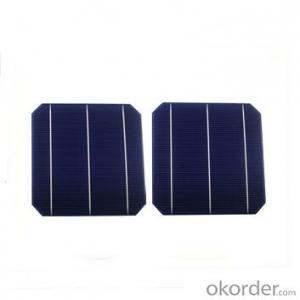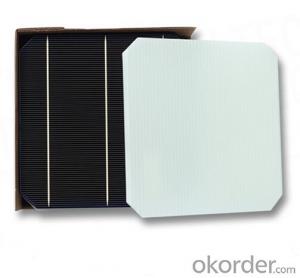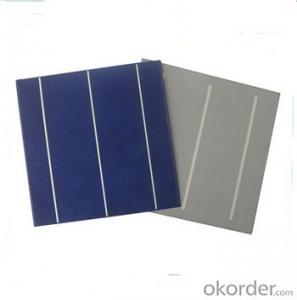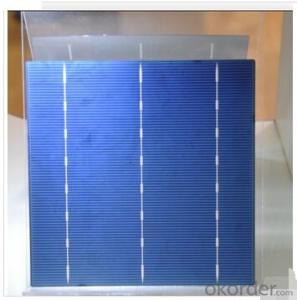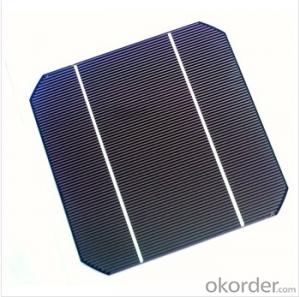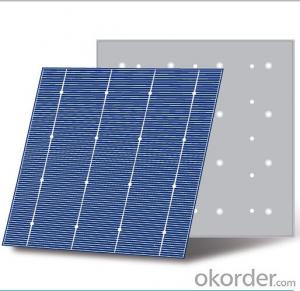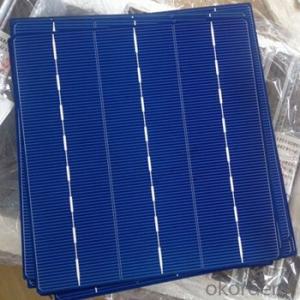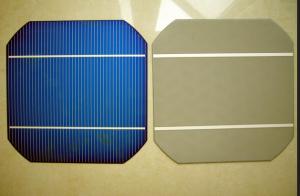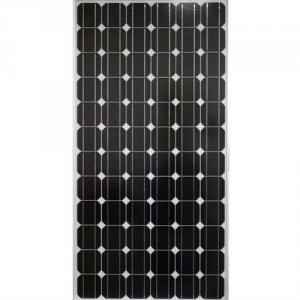Plant Based Monocrystalline Solar Cells Series-- 18.2%
- Loading Port:
- Shanghai
- Payment Terms:
- TT OR LC
- Min Order Qty:
- 1000 pc
- Supply Capability:
- 100000 pc/month
OKorder Service Pledge
OKorder Financial Service
You Might Also Like
Solar Cells:
Solar cells is made by solar wafer, it has three categories of solar cell right now, monocrystalline polycrystalline and thin film,These cells are entirely based around the concept PNjunction, which is the critical part of solar module, it is the part that can convert the light energy into electricity, the thickness is from 180um to 200um, with even busbars to conduct electricity, textured cell can decrease diffuse reflection; they are often electrically connected and encapsulated as a module. Photovoltaic modules often have a sheet of glass on the front (sun up) side, allowing light to pass while protecting semiconductor wafers from abrasion and impact due to wind-driven debris, rain, hail, etc. Solar cells are also usually connected in series in modules, creating an additive voltage. Connecting cells in parallel will yield a higher current;With high quality and stable quality. Our Cells can greatly improve the performance of Solar Modules.
Features:
High conversion efficiencies resulting in superior power output performance.
Outstanding power output even in low light or high temperature conditions
Optimized design for ease of soldering and lamination
Long-term stability,reliability and performance
Low breakage rate
Color uniformity
Specifications:
Dimension: 156mm±0.5mm
Wafer Thickness: 200μm±20μm
Diagonal: 200mm±1.0mm(round chamfers)
Front: 1.5mm Silver bus bars; Blue/others silicon nitride antireflection coating
Back: 3.0mm Silver bus bars; Full-surface aluminum BSF
Efficiency | Efficiency | Pmax(W) | Average | Impp(A) | Vmpp(V) | Isc(A) | Voc(V) |
1840 | 18.30-18.50 | >4.371 | >4.371 | 8.285 | 0.530 | 8.695 | 0.626 |
1820 | 18.10-18.30 | 4.323-4.371 | 4.347 | 8.245 | 0.528 | 8.662 | 0.626 |
1800 | 17.90-18.10 | 4.276-4.323 | 4.299 | 8.190 | 0.526 | 8.630 | 0.625 |
1780 | 17.70-17.90 | 4.228-4.276 | 4.252 | 8.140 | 0.524 | 8.621 | 0.624 |
1760 | 17.50-17.70 | 4.180-4.228 | 4.204 | 8.095 | 0.522 | 8.598 | 0.623 |
1740 | 17.30-17.50 | 4.132-4.180 | 4.156 | 8.045 | 0.520 | 8.568 | 0.622 |
1720 | 17.10-17.30 | 4.085-4.132 | 4.108 | 7.905 | 0.518 | 8.528 | 0.620 |
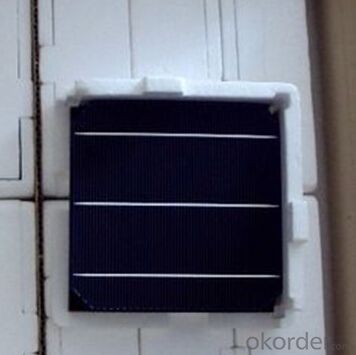
Solar Cells Advantage:
• High efficiency and stable performance in photovoltaic conversion.
• Advanced diffusion technique ensuring the homogeneity of energy conversion efficiency of the cell.
• Advanced PECVD film forming, providing a dark blue silicon nitride anti-reflection film of homogenous color and attractive appearance.
• High quality metal paste for back surface and electrode, ensuring good conductivity, high pulling strength and ease of soldering.
FAQ
We have organized several common questions for our clients,may help you sincerely:
①What price for each watt?
It depends on the efficiency of the solar cell, quantity, delivery date and payment terms.
②How long can we receive the product after purchase?
In the purchase of product within three working days, We will arrange the factory delivery as soon as possible. The pecific time of receiving is related to the state and position of customers.Commonly 7 to 10 working days can be served.
③Can you provide the peripheral products of the solar panels, such as the battery, controller, and inverter? If so, can you tell me how do they match each other?
Yes, we can, we have two companies for solar region, one is CNBM International, the other is CNBM engineering Co.
We can provide you not only the solar module but also the off grid solar system, we can also provide you service with on grid plant.
④What is your warranty of solar cell?
Our product can promise lower than 0.3% open box crack, we support claim after opening the box if it has crackm color difference or sth, the buyer should give pictures immediately, we can not accept the claim after the solar cell has assembled to solar panel.
• Timeliness of delivery
• ⑤How do you pack your products?
We have rich experience on how to pack the solar cell to make sure the safety on shipment, we could use wooden box or pallet as buyer's preference.
- Q: Can solar cells be used in powering electric boats?
- Yes, solar cells can be used to power electric boats. Solar panels can be installed on the boat's surface to capture sunlight and convert it into electricity, which can then be used to power the boat's electric motor and other electrical systems. This enables the boat to operate without relying on traditional fuel sources, making it a more environmentally friendly and sustainable option.
- Q: How do solar cells perform in areas with high levels of humidity?
- Solar cells generally perform slightly less efficiently in areas with high levels of humidity. This is because the moisture in the air can scatter and absorb some of the sunlight before it reaches the solar cell, reducing its overall power output. However, modern solar cell technologies have been developed to minimize this effect and maintain a satisfactory performance even in humid conditions.
- Q: Can solar cells be used in water desalination?
- Yes, solar cells can be used in water desalination. Solar-powered desalination systems, such as solar stills and solar-powered reverse osmosis, utilize solar energy to convert saltwater into fresh water, making it an environmentally-friendly and sustainable solution for water scarcity in coastal areas.
- Q: Can solar cells be used for powering manufacturing facilities?
- Yes, solar cells can be used for powering manufacturing facilities. Solar energy is a renewable and clean source of power that can be harnessed through solar cells, also known as photovoltaic (PV) panels. By installing a sufficient number of solar panels, manufacturing facilities can generate electricity to meet their energy demands. This not only reduces reliance on traditional fossil fuels but also helps in reducing greenhouse gas emissions, making it an environmentally friendly solution for powering manufacturing operations.
- Q: Can solar cells be used in areas with high pollution?
- Yes, solar cells can be used in areas with high pollution. However, it is important to note that pollution can have a negative impact on the efficiency and performance of solar cells. Airborne pollutants, such as particulate matter and smog, can reduce the amount of sunlight reaching the cells, thereby decreasing their output. Regular maintenance and cleaning may be required to ensure optimal performance in polluted environments. Additionally, advanced solar cell technologies and designs are being developed to mitigate the effects of pollution and improve their efficiency in such areas.
- Q: Can solar cells be used for outdoor signage?
- Yes, solar cells can be used for outdoor signage. Solar cells can convert sunlight into electricity, which can power the lighting or display systems used in outdoor signage. This eliminates the need for grid electricity, reducing costs and making outdoor signage more sustainable and environmentally friendly.
- Q: Do solar cells work in cloudy weather?
- Yes, solar cells can still generate electricity in cloudy weather, although their efficiency may be reduced compared to direct sunlight.
- Q: Can solar cells be combined with energy storage systems?
- Yes, solar cells can be combined with energy storage systems. This combination allows for the capture and storage of excess solar energy generated during periods of high sunlight, which can then be used during times when solar energy is not available. Energy storage systems help address the intermittent nature of solar power, ensuring a continuous and reliable energy supply.
- Q: Is A grade better than the B grade when we buy the poly solar cells.
- The quality of the poly solar cell is differentiated by grade, therefore, A grade is better than B grade.
- Q: Can solar cells be used for hydrogen production?
- Yes, solar cells can be used for hydrogen production through a process called photoelectrolysis, where the energy from sunlight is used to split water molecules into hydrogen and oxygen.
Send your message to us
Plant Based Monocrystalline Solar Cells Series-- 18.2%
- Loading Port:
- Shanghai
- Payment Terms:
- TT OR LC
- Min Order Qty:
- 1000 pc
- Supply Capability:
- 100000 pc/month
OKorder Service Pledge
OKorder Financial Service
Similar products
Hot products
Hot Searches
Related keywords
